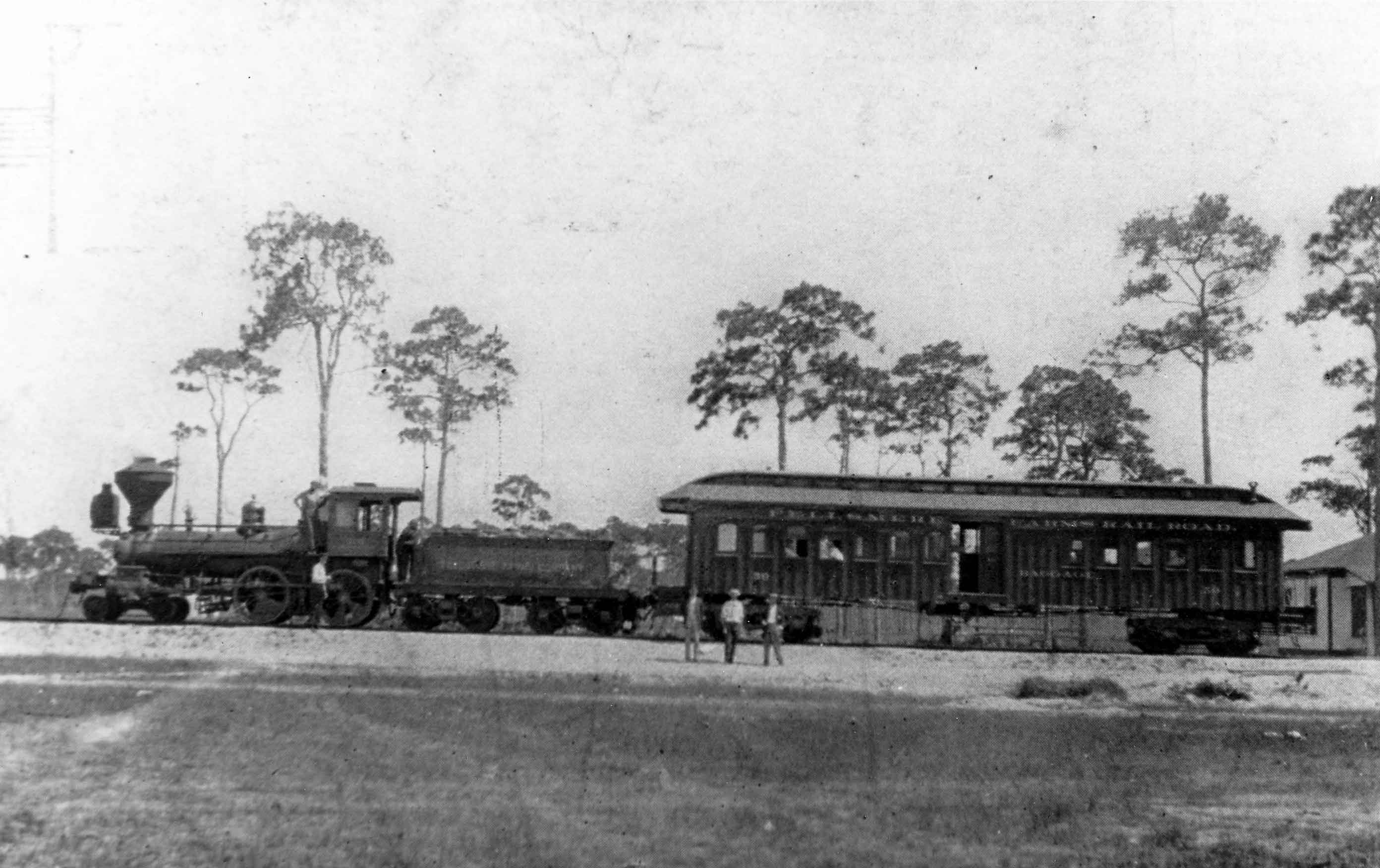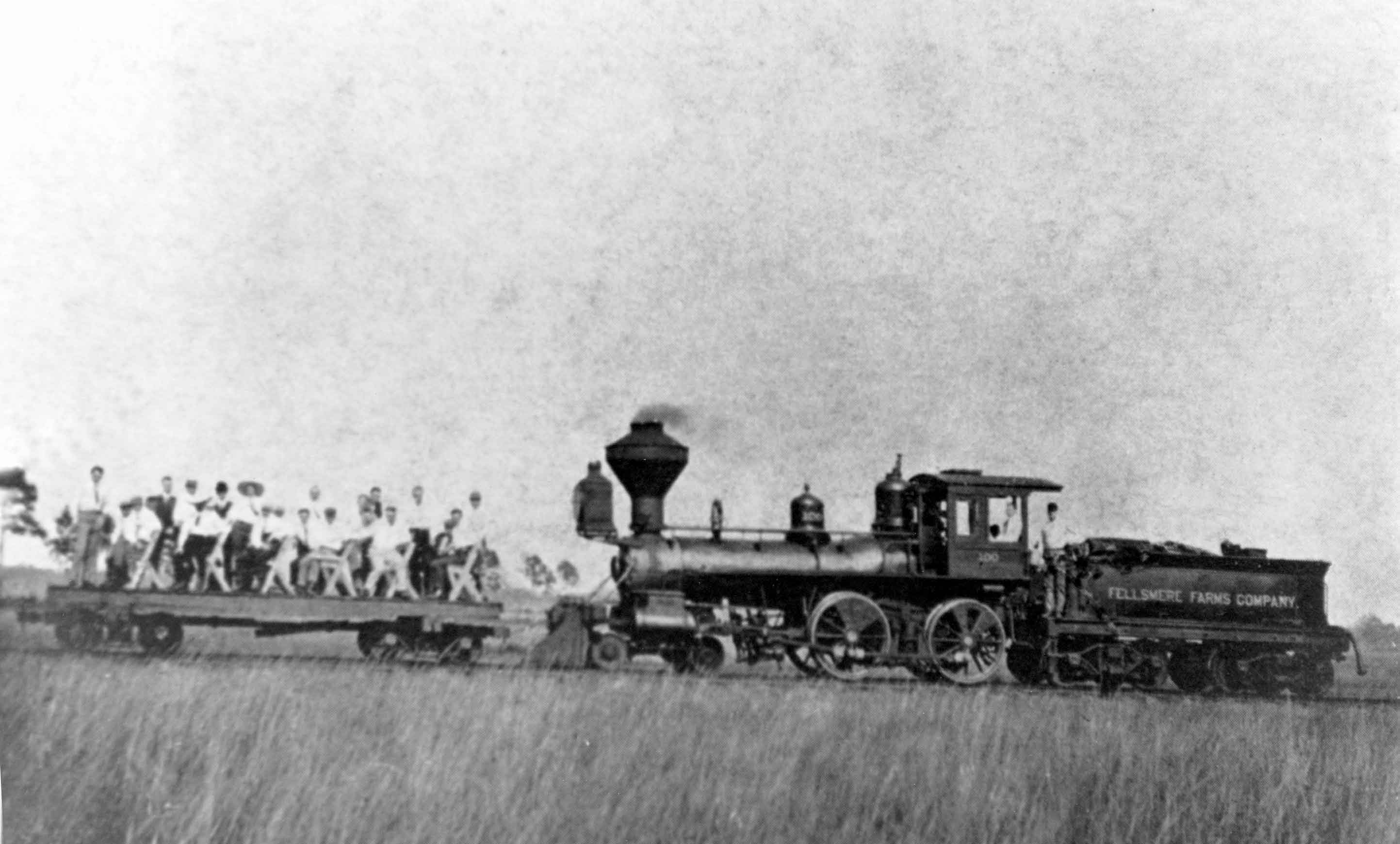
The Trans-Florida Central RR
By
Donald R. Hensley, Jr.
© Copyright
2006-2007 by Donald R. Hensley, Jr.
Part 1
The Fellsmere Farms and it's Railroad.
Revised and Condensed October 2009.
Florida always had men of vision
who tried to tame the swamps and reclaim the land for settlement. They would
buy Florida swamplands at rock bottom prices and try to drain the lands by
digging canals and running the water into rivers or bays. Sometimes they would
succeed and sometimes they would lose everything. The Fellsmere project began
in 1896 when the Cincinnatus Glades Co. bought 184 square miles (118,000 acres)
of swampland west of Sebastian, Florida. A railroad was built from the newly
built Florida East Coast Railway at Sebastian, which ran west 1o miles to
Cincinnatus Farms. The railroad was called the Sebastian & Cincinnatus RR
though it had no legal standing, as the owners never incorporated the railroad.
Over 34 miles of drainage canals were dug and 5 to 10 acre farm lots were
advertised for sale in Cincinnati, OH and the Midwest. Then disaster struck in
1907 and 1908 as two hurricanes and heavy rain filled the canals past their
capacity and the entire region was under three feet of water. The canals filled
with sand and the entire project was abandoned until the owners sold out to the
Fellsmere Farms Co. in 1909.

Fellsmere Farms 100 with Jim Crow combine at Fellsmere in 1911. (Collection of Seth H. Bramson, Miami, FL)
The Fellsmere Farms Co.'s
guiding light was E. Nelson Fells, a mining engineer from England who had lived
in the United States since 1882 and was familiar with Florida and its swamps.
Fells was joined by financier Oscar T. Crosby of Wilmington, Delaware who
provided the money for the project. The Fellsmere Farms Co. was incorporated
for $4,000,000 and the 225 men on their payroll began digging the drainage
canals once again. The Fellsmere Railroad was incorporated in 1909 and Ernest
H. Every of Fellsmere was appointed General Manager. L.S. Lloyd was hired on as
the Chief Engineer and he began at once in rebuilding the railroad between
Sebastian and Fellsmere (Cincinnatus Farms), which was accomplished by 1910.
Lloyd was also in charge of digging the drainage canals. Other officials were
J. Green Carter as General Superintendent, R.L. James as Auditor and Train
Master and M.E. Hull as General Freight Agent.
Here is a description of the line in 1911-1912: The mileage
between Sebastian and Fellsmere was pegged at 9.83 miles and they had 15
trestles totaling 451 feet. The largest was 130 feet long while the shortest
was just 10 feet. There was only 6 curves on the line totaling just .46 miles,
the rest of the railroad was entirely straight. There were 10 ascending grades
that raised 29.6 total feet for 4.51 miles and 11 descending grades totaling
21.6 total feet for 3.92 miles. Only 1.40 miles was perfectly level. The rail
was 60 lb steel and the ties were yellow pine (7"x9"x8'6" with 2
foot spacing) and the usual Florida sugar sand ballast.

Fellsmere Farms # 100 with a sightseeing excrusion into the glades. Wanna buy some swamp land real cheap?
(Collection of Seth H. Bramson, Miami, FL)
They owned one steam locomotive, one gas motorcar, one combination
passenger and baggage car (ex Long Island RR # 5 bought from Georgia Car &
Locomotive Co in 1911), one box car and three flat cars. They employed one
train crew consisting of one engineer ($4.49 a day), one fireman ($2), one
conductor ($3.07) and two trainmen ($1.50 each). They also had a motor car man
at $3.05 a day and two section crews with 22 men whom they paid an average of
$1.46 a day. These were considered high wages for this era so it must have been
hard to hire experience men and get them to live in the swamp. Accordingly
their expenses were very high for the year at $16,299 while their income was
only $8,136. However the Fellsmere Farms Co. knew that the railroad would never
turn a profit and hoped that their own income would more then offset the
railroad losses. They needed the railroad to bring in prospectus customers and
to bring in supplies, mail and express so that the residents of Fellsmere could
live a normal life.

Fellsmere 100 with a train load of parts for the canal builders. (Florida State Photograic Archives)
The first locomotive purchased
was a 4-4-0 Rogers built steamer bought from Georgia Car & Locomotive Co.
shop number 120 on November 3, 1910 and was lettered and numbered as Fellsmere
RR # 100. The Ocala Northern Ry.
originally owned this balloon stack wood burner and was numbered 4 on its line.
However this 14x22" engine was too small for even the Fellsmere RR and it
after two years it was traded in to
Georgia Car & Locomotive #208 and was resold to Southern Hardwood Mfg. Co.
# 3 on May 20, 1912.
The second locomotive was
slightly bigger, a 16x24" Baldwin c/n 4790 built in September of 1879.
Purchased with cash and the trade in of #100 from Georgia Car & Locomotive
# 183 it became Fellsmere RR # 101. Originally built by Baldwin for the Atlanta
& West Point # 23 "L.P. Grant", it was sold to the Western Ry. Of
Alabama which then sold it to the Aberdeen & Ashboro #25, whom finally sold
it to GC&L.
Business had picked up in 1913
so they went back to Georgia Car & Locomotive Co. one more time and
purchased GC&L # 136 to become Fellsmere RR # 102. This was an even bigger engine with 17x24"
cylinders and weighed 49 tons. Built by Cooke c/n 1812 in July of 1887
originally for the Minnesota & Northwestern #44. Later becoming in succession the Chicago St. Paul & Kansas
City #44 and Chicago & Great Western # 44 in 1892. Sold to the Joseph Iron Co. as scrap in 1910
the GC&L purchased the engine for resale as their shop number 136. Revenues
were up in 1913 as they made $14,305 but expenses also went up to $29,115
losing almost 15 grand in the process.
During
1913-14 they tried cutting back on maintenance of way, firing one section crew
and keeping on just 8 men to oversee the almost ten miles of track. Passenger
business was so heavy that they sold their old combine and added two newer
cars. One was a 28 seat wooden Jim Crow passenger car with a center baggage
area. The other was a 52 seat wooden passenger coach. These were also purchased
from the Georgia Car & Locomotive Co. in September of 1913. A new depot at
Fellsmere was also finished in 1913. This board & batten 12x32' building
had a shingle roof and a 75 foot platform. Like most segregated facilities in
the south at this time, the whites were separated from the blacks by a central
12x14' office building. The depot was located on the south side of the
mainline. A new 16x50' freight depot was also built on the north side of the
track The total expenses for 1913-14 were $32,646 with revenues of $14,571,
this time losing more then $18,000.
In 1915 the new chief engineer
William Alden James ran surveys and construction began on an extension to
Broadmoor at milepost 16.17. It was said that they were shooting for the
Kissimmee Valley extension of the Florida East Coast Ry. but ran low on cash.
Also in 1915 a new gas motor car was built giving the Fellsmere two cars. The
railroad lost $12,000 in 1915 on revenues of $16,720.
The extension to Broadmoor was
finished by April of 1915 and lots were quickly put on the market to be sold.
But this land was built on muck land near Lake Wilmington and in early 1916 a
heavy rain hit the area for two days with sixteen inches of rain. The town was
wiped out. The extension was not operated in 1916 and revenues would only hit
$10,399 that year with nearly a $9,000 loss. Many changes were made in
leadership as W.P. Nipson, the mechanical superintendent was hired to replace
J. Green Carter as the General Superintendent. L.S. Lloyd returned to replace
William A James as Chief Engineer. A snapshot of operations for 1916 shows
13,600 locomotive miles for mix trains and 3,840 miles for switching. For a 10
mile railroad that’s 1360 trips for the year, but they did meet every Florida
East Coast passenger train with two round trips a day at Sebastian.

Things went down hill fast as
Fellsmere Farms and the Fellsmere RR was placed under receivership on January
5, 1917 by W.H. Tallis. He replace H.B. Nipson with R.E. Mudge as General
Superintendent on June 1, 1917. Revenues for 1917 were $9839 resulting in a
loss of over $5,000.
Reorganization continued into
1917-1918 as the Fellsmere Farms Co. became the Fellsmere Co. with W.H. Tallis
as president, replacing E. Nelson
Fells, who was forced out of the company he had formed. Mr. Tallis also took
over the General Manager's duties as well. Combination of bad weather, a
fertilizer shortage and land owners giving up and moving away really hampered
the railroad during 1918 and the road recorded it's lowest revenues, posting
only $5,937 with expenses of $8,187. Steam Locomotive # 101 was sold or
scrapped that year, being replaced with another gas motor car, giving them
three. Contrary to local rumors the road was not taken over by the Federal
Government and it did not sell off its passenger cars for troop movements in
the northeast. This is verified by the Florida Railroad Commission reports.
The year 1918-1919 saw the firing of Mr. Mudge as Mr. Tallis assumed control over those
duties as well. In fact he cut the railroad to the bare bone by firing the
entire section crew, with all maintenance of way duties performed from time to
time by different employees. Also this period saw the rise of the motor car, as
he hired a new mechanical superintendent, J.E. Dixon, who was put in charge of
converting and keeping these machines running. As most of the train crew was
laid off, the motor cars were sometimes operated by other employees including
the Fellsmere agent/telegrapher. The steam locomotive was very seldom fired up.
Mr. Dixon rebuilt one motor car using the parts from the other two. Revenues
were up a little this year, as the road made $6475, but expenses were $7832 and
the road once again lost money. Same for 1919-20, as they earned $8203, but
still lost over $1200.
Durring 1920 steam locomotive # 101 was prematurely retired, only to get a reprieve a year later. Revenues for 1921 were down to $5579 as they lost $1500. Next year saw them scrapping a motor car and building a new one. Revenues dipped once again as they only earned $4,334 which saw the red ink of over $1200. A new mechanical superintendent was hired, W.E. Feazell, Jr.
